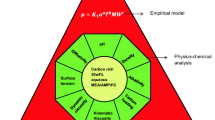Abstract
Recently there have been growing concerns that anthropogenic carbon dioxide (CO2) emissions cause the global warming problem. Therefore, the cutting-edge technologies for the reduction, separation and collection of the CO2 are very important to alleviate this problem. The best methods for reducing the CO2 emission are to increase the energy efficiency and to remove it from the power plant. The CO2 absorption from the syngas in the integrated gasification combined cycle (IGCC) might increase the energy efficiency of the power generation systems, which also contribute to mitigate the global warming. In this study, the suspensions of nanoparticles in methanol (called the nanofluid) are developed and estimated to apply it to absorb CO2 gas in the IGCC systems. The nanofluids are prepared by the ultrasonic treatment and show the good stability. It is found that the CO2 absorption rate by the nanofluid is enhanced up to ∼8.3% compared to the pure methanol.
Similar content being viewed by others
References
J. D. Figueroa, T. Fout, S. Plasynski, H. McIlvried and R. D. Srivastava, Advances in CO2 capture technology — The U.S. department of energy’s carbon sequestration program, Int. J. Greenh. Gas Control, 2 (2008) 9–20.
A. L. Ahmad, A. R. Sunarti, K. T. Lee and W. J. N. Fernando, CO2 removal using membrane gas absorption, Int. J. Greenh. Gas Control, 4 (2010) 495–498.
W. G. Kim, H. U. Kang, K. M. Jung and S. H. Kim, Synthesis of silica nanofluid and application to CO2 absorption, Sep. Sci. Tech., 43 (2008) 3036.
Z. J. Zhang, W. Zhang, X. Chen, Q. B. Xia and Z. Li, Adsorption of CO2 on zeolite 13X and activated carbon with higher surface area, Sep. Sci. Tech., 45 (2010) 710–719.
H. M. Chang, M. J. Chung and S. B. Park, Cryogenic heatexchanger design for freeze-out removal of carbon dioxide from landfill gas, J. Therm. Sci. Tech., 4 (2009) 362–371.
J. S. Dennis and S. A. Scott, In situ gasification of a lignite coal and CO2 separation using chemical looping with a Cubased oxygen carrier, Fuel, 89 (2010) 1623–1640.
S. Krishnamurthy, P. Lhattacharya, P. E. Phelan and R. S. Prasher, Enhanced mass transport in nanofluids, Nano Lett., 6 (2006) 419–423.
J. K. Lee, H. Kim, M. H. Kim, J. Koo and Y. T. Kang, The effect of additives and nanoparticles on falling film absorption performance of binary nanofluids (H2O/LiBr+ panoparticles), J. Nanosci. Nanotech., 9 (2009) 7456–7460.
V. Linek, M. Kordac and M. Soni, Mechanism of gas absorption enhancement in presence of fine solid particles in mechanically agitated gas-liquid dispersion. Effect of molecular diffusivity, Chem. Eng. Sci., 63 (2008) 5120–5128.
J. K. Lee, J. Koo and Y. T. Kang, The effects of nanoparticles on absorption heat and mass transfer performance in NH3/H2O binary nanofluids, International Journal of Refrigeration, 33(2010) 269–275.
H. Kim, J. Jeong and Y. T. Kang, Heat and mass transfer enhancement for falling film absorption process by SiO2 binary nanofluids, International Journal of Refrigeration, 35(2012) 645–651.
T. Zhu, S. Yang, D. Choi and K. Row, Adsorption of carbon dioxide using polyethyleneimine modified silica gel, Korean J. Chem. Eng., 27 (2010) 1910–1915.
J. P. Holman, Experimental Methods for Engineers, 7th ed. McGraw-Hill: New York (2001).
J. Y. Jung, J. Koo and Y. T. Kang, Model for predicting the critical size of aggregates in nanofluids, Submitted to Heat and Mass Transfer (2012).
K. C. Ruthiya, J. van der Schaaf, B. F. M. Kuster and J. C. Schouten, Influence of particles and electrolyte on gas holdup and mass transfer in a slurry bubble column, Int. J. Chem. Reactor Eng., 4 (2006) A13.
S. Krishnamurthy, P. Bhattacharya, P. E. Phelan and R. S. Prasher, Enhanced mass transport in nanofluids, Nano Lett., 6 (2006) 419–423.
Author information
Authors and Affiliations
Corresponding author
Additional information
Recommended by Associate Editor Dongsik Kim
Jung-Yeul Jung received his Ph.D degree in Mechanical Engineering from Chung-Ang University in 2007. He is a senior researcher in Korea Ocean Research and Development Institute since 2011. His research interests are CO2 capture and storage (CCS), heat & mass transfer, nanofluid, biosensor.
Jae Won Lee received his B.S. degree in Mechanical Engineering from Kyung Hee University in 2010. Currently, he is a combined M.S. & Ph.D student at the Department of Mechanical Engineering, Kyung Hee University, Yongin, Korea. His researcher interests are CO2 absorption & regeneration, CO2 flow visualize, heat & mass transfer, nanofluids.
Yong Tae Kang received his BS, MS and Ph.D in Mechanical Engineering from Seoul National University in 1987 and 1989, and The Ohio State University in 1994, respectively. Currently, he is a Professor at the Department of Mechanical Engineering, Kyung Hee University, Yongin, Korea. His researcher interests are CO2 absorption & regeneration, heat & mass transfer, nanofluids, heat pump and air conditioning and refrigeration.
Rights and permissions
About this article
Cite this article
Jung, JY., Lee, J.W. & Kang, Y.T. CO2 absorption characteristics of nanoparticle suspensions in methanol. J Mech Sci Technol 26, 2285–2290 (2012). https://doi.org/10.1007/s12206-012-0609-y
Received:
Revised:
Accepted:
Published:
Issue Date:
DOI: https://doi.org/10.1007/s12206-012-0609-y




